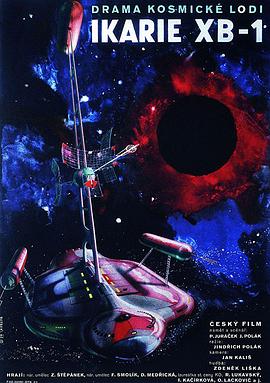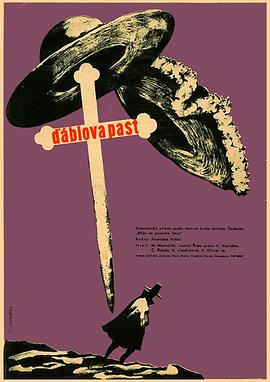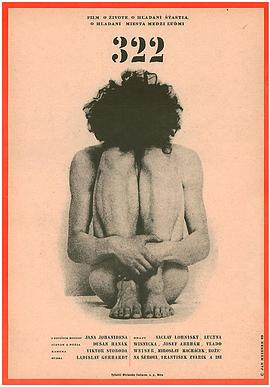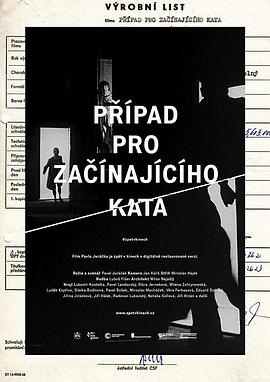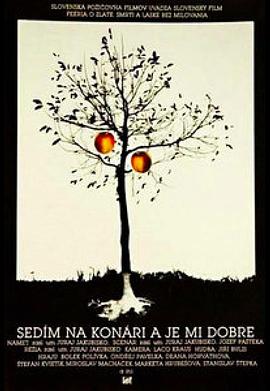米罗斯拉夫·马
搜索"米罗斯拉夫·马",找到5部影视作品
导演:
/金德里奇·波拉克
主演:
剧情:
未来的2163年。人类的40名成员驾驶超光速宇宙飞船飞出太阳系,他们的目的地是阿尔法星人马座。在那里找寻是否有和人类一样的生命存在。完成任务后,将经过15年的飞行返回地球。 但是旅程中却碰到了意想不到的情况…… 《Ikarie XB 1》拍摄于1963年。当时库布里克没有拍出《2001:太空漫游》,人类还没有登上月球。富有想象力的东欧电影人就对宇宙中是否存在除人类以外的生命的问题作出了大胆假想,并在实践中寻找了。本片是捷克斯洛伐克的第一部科幻电影,影片改编自波兰著名的科幻作家 斯坦尼斯拉夫·莱姆的小说《麦哲伦星云》(“Magellan Cloud” )。
导演:
/法兰提塞·维拉席
主演:
剧情:
In the time of Counter-Reformation, a miller and his son come under investigation by a priest of the Inquisition, when rumors spread that their prosperity comes from working with the Devil. The Devil's Trap is a film directed by František Vlá?il, based on a novel by Alfréd Technik, adapted by František A. Dvorák and Miloš Kratochvíl. It was the first of three historical dramas that Vlá?il made during the Czech New Wave (technically he isn't really a part of the New Wave, however these films were made during the same era of artistic freedom), preceding his more well known Marketa Lazarová (1967) and Valley of the Bees (1968). Set in the late 16th Century during the Catholic Reformation, in the Moravian Karst, situated in what is now the Eastern Czech Republic, it tells the tale of a miller (Vítezslav Vejrazka), and his son Jan (Vít Olmer), who come under suspicion and are investigated by a Jesuit priest of the Inquisition (Miroslav Macháchek), when rumors of witchcraft are spread by the local regent (Cestmír Randa), who is jealous of the miller's prosperity and degree of respect among the local populace. As expected from Vlá?il, this film is a stunning experience all the way through. From the opening shot, an ominous manipulation of perspective with a close up of a mangled figure of Christ dominating the foreground against a tiny figure in black walking along the horizon, to the breathtaking confrontational finale inside the vast stalactite filled Karst caverns, it is a wonderful display of visual mastery. Maybe not quite as impressive as Marketa Lazarová, but still full of astonishing imagery. As seen from unique angles and distinct points of view which highlight the director's remarkable sense of awareness of framing, motion, and positioning on the emotional and dramatic tone of the scene. The most memorable being a repeated shot where the camera is suspended and launched with speed through the air towards the miller's door. The story here is a simple one and I would say more accessible than his later works. With a conventional structure emphasized as much by its plot and characters, than by its expressionistic cinematography or authentic historical detail. The events play out without much surprise, and there is a strong underlying, almost supernatural, mysterious aspect that is left unresolved, in fact barely explored, which is slightly disappointing, but only because it's so fascinating that I wish there was more. Acting is great all around. Particularly the villains: Miroslav Macháchek as the priest, casting a sinister and imposing shadow wherever he goes, and Cestmír Randa as the weasel like regent behind all the persecution. While Vít Olmer brings a charismatic leading man presence in his role as the miller's son Jan, in love with the lovely orphan girl Martina (Karla Chadimová), who becomes a dangerous object of rivalry between Jan and other young men of the village. The film also features the evocative music of Zden?k Liška (perhaps the most prolific composer of the Czech New Wave). In this his second of eleven collaborations with Vlá?il, his compositions are used sparingly, but to great effect, complimenting but never overpowering a scene. The best example of which can be heard in an amazingly shot celebration and dance sequence at the end of the second act. The Devil's Trap might not be a masterpiece, but it is still a strong effort, with a fascinating straightforward story and a glorious historical setting captured beautifully by Vlá?il's unmistakable visual prowess. A fine work that would also be the perfect starter plate to prepare yourself for the challenging feast of Marketa Lazarová or The Valley of the Bees. It even has an easy to digest running time. It's therefore puzzling why this gem remains largely overlooked and ignored.
导演:
/杜桑·哈那克
主演:
剧情:
Mannheim-Heidelberg International Filmfestival YearResultAwardCategory/Recipient(s) 1969 Won Grand Prize Dusan Hanák A government official in Czechoslovakia mistakenly believes he has cancer. He reasons his involvement in clandestine activities during the Stalin administration have fated him to die from a dreaded disease. He searches for inner peace as he feels the guilt of his past transgressions. This film tied for the Grand Prize at the Mannheim Film Festival in 1969. Slovak director Dusan Hanak was one of Czech cinema's brightest and best talents of the '60s and '70s, but because of censorship this was not manifest until the late '80s. Dusan made an impact on the film world with his auspicious debut 322 (1969). Though banned until 1988, when it was finally released, it earned international acclaim and the Grand Prix award at the Mannheim Film Festival. Hanak's sophomore effort, the documentary Obrazy Stareho Sveta/Image of an Old World (completed in 1972), was also not released until 1988 and neither was his 1980 film Ja Milujem, Ty Milujes/I Love You, You Love. Only Hanak's 1976 film Ruzove Sny/Rose-Tinted Dreams passed muster with censors and saw a timely release.
导演:
/帕维尔·祖拉契克
主演:
剧情:
本片堪称一部现代版的“格利佛漫游记”,改编自斯威福特愤世嫉俗的社会政治讽刺名著。Lubomir Kostelka扮演现代格利佛,在一次翻车后他突然醒来,走过一片森林后,他开始寻找一个神秘的国度勒普泰,因为他听说那是一个美好的地方,在路上他发现了一只死去的穿着人的衣服的兔子,从它的口袋中拿出来一块怀表,他发现那怀表的时间是反向走的,于是他继续往前走,遇见了形形色色奇怪而复杂的人和事,一场荒诞的超现实历险就此展开 《为年轻刽子手的辩护》被国际上公认为祖拉契克最完美的电影杰作,是60年代捷克新浪潮电影运动中最重要也是最“声名狼藉”的一部作品。这部狂热的,稀奇古怪的政治讽刺剧完成于苏联坦克入侵之后,在其上映后立刻被当局封禁,并永远终结了祖拉契克的电影生涯。大胆的,创新的和绝对荒诞主义式的影像,《为年轻刽子手的辩护》是电影史上对格利佛漫游记最疯狂的一次改编,全片几乎摆脱了所有剧情和思维逻辑的形式和束缚,让观众们完全进入一个象征主义和符号主义的幻想世界。作为影史上所公认的“最伟大的超现实主义电影杰作之一”,这部影片呈现给我们无数古怪而充满隐喻性的画面,一只身穿衣服的兔子,一座专门研究发明创造的高等学校但里面所有的学生都是从不说话的,一个精致的“手工提供动力”的思想机器,一个没有一年中的第九个月份的国家(为了避免流感的流行)。。。我们的英雄格利佛经历并发现了这一切,在他从小人国到Balnibari前往勒普泰的路程中。“这部影片包含了所有能超出你想象的荒诞剧元素,超现实主义元素和讽刺剧元素,是乌托邦式的政治讽刺剧和怪诞的童话故事的一次完美融合。”(鹿特丹国际电影节评语) 关于导演: 帕维尔.祖拉契克(1935-1989),捷克新浪潮电影运动中的天才导演/编剧/制片人,被誉为“捷克新浪潮电影革命中真正的灵魂”,作为整个东欧电影新生运动中最独特的剧作家之一,他创作了好几部在捷克和东欧电影史上占有重要地位的影片,1963年由他所编剧,Jindrich Polak导演的《Ikarie XB-1》是电影大师库布里克最钟爱的十部影片之一,同时也是影响其《2001太空漫游》创作的灵感源泉,1964年为捷克动画大师Karl Zeman所创作的《The Jester's Tale》是一部融合了动画,真人和奇特摄影术的幻想片经典,1966年他与新浪潮另一位著名剧作家Ester Krumbachova共同创作了《Daisies》,由Vera Chytilova执导,成为新浪潮中最独特的一部杰作,一年后他又为捷克科幻电影大师Jan Schmidt编剧了其最好的作品《End of August at the Hotel Ozone》;作为制片人,他是Vera Chytilova的名作《天堂的果实》(1969)和Jiri Menzel最富传奇色彩的电影《弦上的云雀》(1969年拍摄,1990年解禁)的执行制片;而作为一位极具创新意识的电影导演,他一生却只拍摄了两部长片和一部短片,由于69年的《为年轻刽子手的辩护》中对共产主义和极权主义的批判和讽刺,影片被当局禁映并永远禁止祖拉契克再拍摄任何影片,两年后,祖拉契克也被免去了在Barrandov电影工作室的工作,1977年他被迫流亡西德,经过6年不得志的生活后回到祖国但依然看不到重新创作电影的希望,1989年,就在捷克共产主义政权垮台的前夕,郁郁寡欢的祖拉契克在布拉格永远闭上了眼睛,终年只有54岁,他成为捷克20年的共产主义极权专政下少有的被终生禁止拍片的捷克电影导演,而他的悲哀逝去,在后来被公认为极权主义摧毁践踏所有艺术创作和优秀电影人所犯下的最惨痛的一次伤亡,世界上从此失去了一位具有创新和独特的个人风格,堪称能与费里尼媲美的电影天才。纵观他的电影生涯,几乎每部创作的作品都堪称经典,尤其是其仅存的两部导演作品更是充分展现奇思妙想的电影杰作,而由于他的影片存世很少也极难看到,以至于至今这位电影奇才依然默默无闻,2004年8月,纽约著名的CINEMATHEQUE实验院线与布拉格国家电影资料馆在两地共同举办了祖拉契克的电影回顾展,取名为“为帕维尔.祖拉契克的辩护 -- 重发现一位捷克新浪潮电影大师”,向世界范围内推荐并缅怀这位英年早逝的东欧电影奇才。 一点个人感受: 《为年轻刽子手的辩护》祖拉契克的第二部长片也是其最后的一部作品,被后来者公认为继齐蒂洛娃的《雏菊》之后最具独特魅力的新浪潮电影,而两部影片的编剧同为祖拉契克。影片从一开始就给我们展现出一个奇特的超现实世界,一个男人开着车在空无一人的乡间山道上行驶着,突然车子翻下山谷,镜头一转,男人睁开眼,原来是一场梦,男人继续往前走,一只穿着衣服的兔子死在路中间,男人俯身下去拿出衣服口袋中的一块怀表,赫然发现指针是倒着转的,男人继续往前走过一片田野,来到一座空无一人的白色建筑前,走进去,里面杂乱无章,墙壁上挂着一件和兔子身上一模一样的衣服,男人自然上去摸摸口袋,突然总口袋中飞出无数蝴蝶,男人本能地闭上眼,等他再睁眼一看,所有杂乱的东西都消失了,而自己却身处一个一尘不染的白色大厅中。。。之后突然晃动的地板,从房顶上坠落却突然进入一个陌生的房间,一群人仰头观看一头牛被判的绞刑。。。无数具有象征主义的画面和高超的剪辑技巧使这部影片成为一部完全以影像说话的杰作,这部影片在超现实的影像上绝不亚于布努艾尔和达利的《安达卢奥犬》或《黄金年代》,而被送上绞刑架的牛则暗示着极权主义的最终命运。影片中那些精致而有创意的摄影来自新浪潮著名的电影摄影师Jan Kalis。 转自Auess

